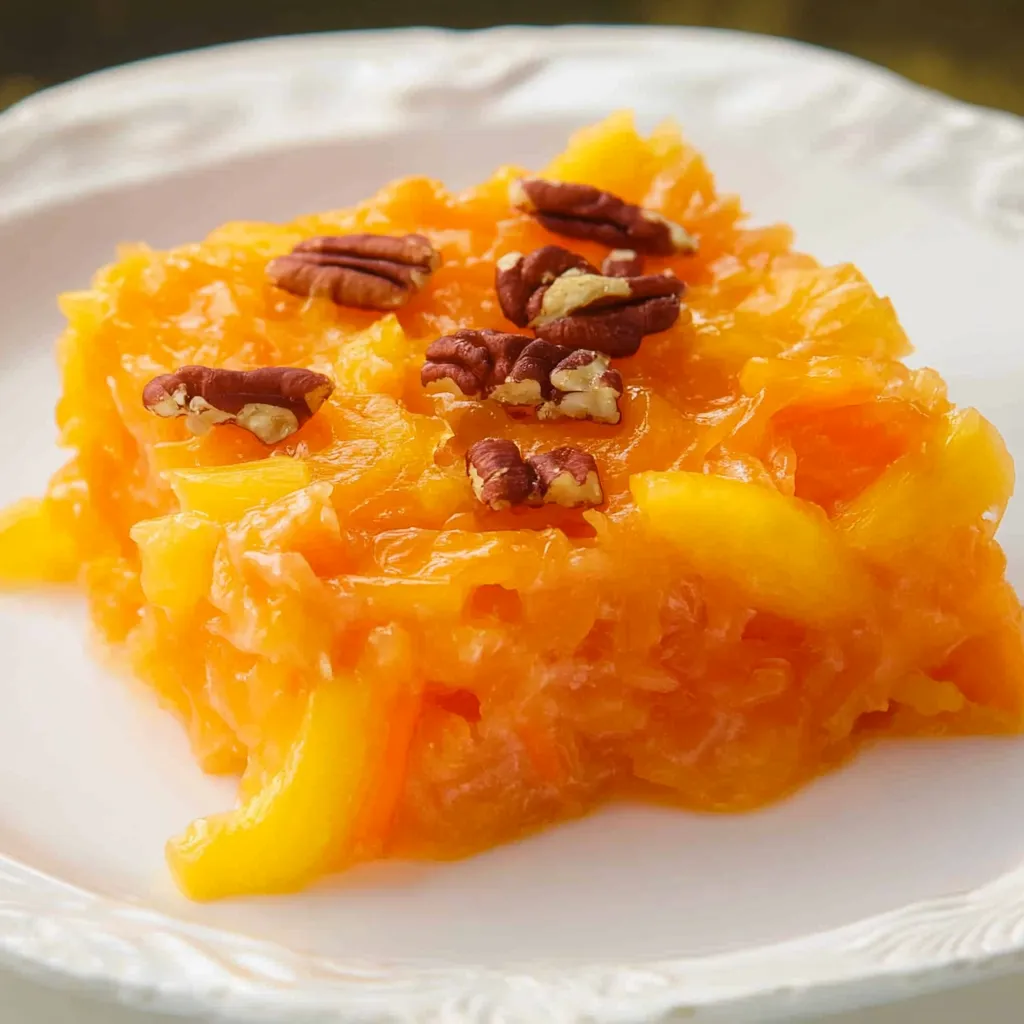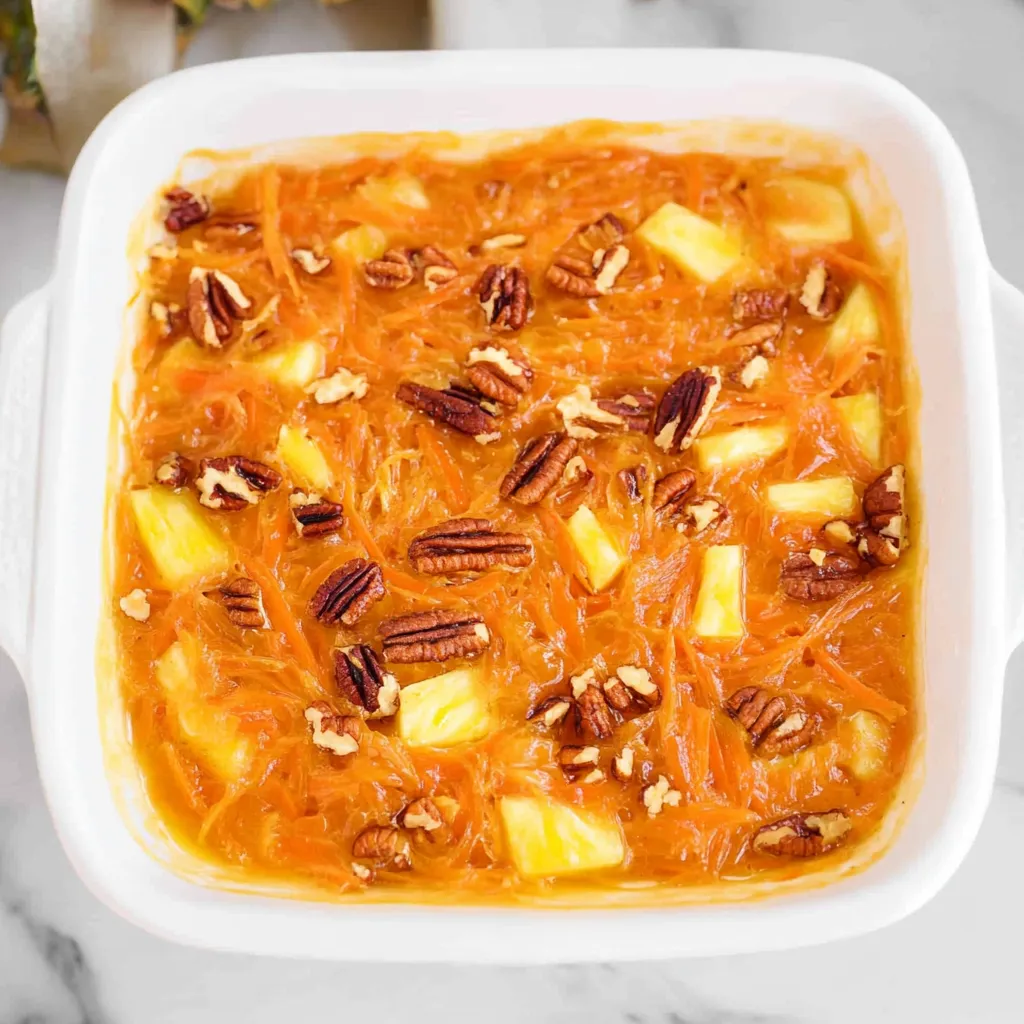 Pin it
Pin it
This vibrant gelatin salad brings together the best of Southern comfort food with refreshing fruit flavors and satisfying textures. Packed with crushed pineapple, freshly grated carrots, and crunchy pecans suspended in bright lemon gelatin, this dish offers a delightful combination of sweet, tangy, and nutty flavors. Whether served as a light side dish or a refreshing dessert, this colorful creation adds both visual appeal and nostalgic charm to any meal.
I grew up watching my grandmother make variations of this salad for every family gathering, and there was always friendly competition among the aunts about whose version was best. When I first made this recipe as an adult, I was surprised by how much I genuinely enjoyed it - the combination of sweet pineapple, earthy carrots, and crunchy pecans creates something much more sophisticated than I remembered. Now I make it for potlucks and holiday meals, and it always disappears faster than expected.
Essential Ingredients and Selection Tips
- Lemon gelatin powder: Choose name-brand gelatin for the most reliable setting and brightest color
- Crushed pineapple in juice: Always buy pineapple packed in juice rather than syrup for fresher, less cloying flavor
- Fresh carrots: Grate your own for the best texture; pre-shredded carrots are often too dry
- Fresh lemon juice: Adds brightness that enhances the gelatin flavor without overpowering
- Pecans: Buy whole pecan halves and chop them yourself for better texture and fresher taste
- Quality mayonnaise: If serving with mayo on top, use full-fat for the richest, creamiest contrast
Detailed Cooking Instructions
- Prepare the pineapple base carefully:
- Open your can of crushed pineapple and drain it through a fine-mesh strainer, pressing gently to extract juice without mashing the fruit. Reserve every drop of this precious pineapple juice in a measuring cup. To the reserved juice, add fresh lemon juice and enough cold water to make exactly one cup of liquid. This mixture will provide both flavor and the proper liquid ratio for your gelatin to set correctly. Set the drained pineapple pieces aside in a covered bowl.
- Create the gelatin foundation:
- Bring 1 cup of water to a full rolling boil in a small saucepan or using a kettle. In a medium mixing bowl, pour the boiling water over the lemon gelatin powder. Whisk vigorously for 2-3 minutes until every granule of gelatin completely dissolves and the mixture is crystal clear. Any undissolved gelatin will create lumps in your finished salad, so take time to ensure complete dissolution.
- Combine liquids for proper setting:
- Slowly pour the pineapple juice mixture into the dissolved gelatin, whisking constantly to prevent any separation or clumping. The mixture should be smooth and evenly colored. Pour this liquid gelatin into your chosen mold - either an 8x8 inch square dish for easy cutting or a decorative mold for special presentation. Place in the refrigerator and chill for 45 minutes to 1 hour, checking every 15 minutes after the first 30 minutes.
- Test for perfect consistency:
- Your gelatin has reached the right stage when it's thickened to the consistency of raw egg whites. It should jiggle when gently shaken but still be liquid enough to stir. If it's too firm, your mix-ins will sit on top rather than being evenly distributed. If it's still completely liquid, give it another 15-20 minutes in the refrigerator before checking again.
- Fold in the texture elements:
- Remove the partially set gelatin from the refrigerator and add the reserved crushed pineapple, freshly grated carrots, chopped pecans, and a pinch of salt. Using a large spoon or spatula, fold these ingredients gently but thoroughly throughout the gelatin, making sure they're evenly distributed. Work quickly but carefully to maintain the gelatin's setting properties while ensuring every bite will have a good mix of ingredients.
- Complete the setting process:
- Return the mold to the refrigerator and chill for at least 4 hours, though overnight is ideal for the firmest, most sliceable texture. The salad is ready when a knife inserted into the center comes out clean and the gelatin holds its shape when cut. For serving, dip the bottom of the mold briefly in warm water to loosen, then cut into squares or unmold onto a serving plate.
 Pin it
Pin it
The beauty of congealed salads lies in their ability to transform simple ingredients into something special through technique and presentation. This particular combination celebrates the natural sweetness of pineapple while the carrots add both color and subtle earthiness. The pecans provide essential textural contrast and a distinctly Southern flavor that elevates the entire dish beyond ordinary fruit salad territory.
Understanding gelatin behavior is key to success with this recipe. Gelatin needs specific temperature and timing conditions to set properly while still allowing mix-ins to be incorporated evenly. The partial setting stage is crucial - too liquid and your ingredients sink to the bottom, too firm and they won't distribute properly. This timing comes with practice, but checking the consistency every 15 minutes ensures you catch the perfect moment.
The versatility of this recipe makes it perfect for various occasions and dietary preferences. While traditionally served as a side dish alongside Southern comfort foods, it works equally well as a light dessert or refreshing palate cleanser. The natural fruit content provides vitamins and fiber, while the nuts add healthy fats and protein, making it more nutritionally balanced than many traditional desserts.
This salad represents a fascinating piece of American culinary history, particularly Southern entertaining traditions. Congealed salads became popular in the mid-20th century when gelatin became widely available and reliable. They offered home cooks a way to create impressive-looking dishes that could be made ahead of time - perfect for church suppers, family reunions, and holiday gatherings where advance preparation was essential.
The make-ahead nature of this dish cannot be overstated as an advantage for entertaining. Unlike many salads that wilt or lose their appeal after sitting, this one actually improves with time as the flavors meld and develop. The gelatin holds everything together beautifully, preventing the soggy texture that plagues many mixed salads. This reliability makes it perfect for potluck situations where timing can be unpredictable.
My family has embraced this recipe as part of our holiday tradition, and I love watching younger relatives discover it for the first time. There's something wonderfully retro and charming about serving a beautifully molded salad that feels both nostalgic and fresh. My teenage daughter, who's usually skeptical of anything "old-fashioned," surprised me by requesting this for her birthday dinner last year.
This sunshine salad has taught me to appreciate the wisdom of traditional recipes and the importance of keeping culinary traditions alive. There's real skill involved in creating dishes that are both beautiful and delicious using simple techniques, and this recipe delivers on both counts. Every time I make it, I'm reminded that sometimes the most satisfying foods are those that connect us to our past while creating new memories for the future.
Frequently Asked Questions
- → How long does sunshine salad need to set?
- The salad needs at least 4 hours to set completely, but overnight chilling works best for the perfect texture.
- → Can I use fresh pineapple instead of canned?
- Yes, but you'll need to add extra liquid since fresh pineapple doesn't provide the juice that canned pineapple does.
- → What can I substitute for pecans?
- Walnuts, almonds, or even sunflower seeds work great. You can also leave the nuts out completely if needed.
- → How long does this salad keep in the fridge?
- Covered sunshine salad stays fresh in the refrigerator for up to 5 days, making it perfect for meal prep.
- → Do I have to use mayonnaise on top?
- No, the mayonnaise is totally optional. Many people love it plain, while others prefer a small dollop for extra creaminess.
- → Can I make this in individual molds?
- Absolutely! Small individual molds or even muffin tins work perfectly for single servings at parties or dinners.
